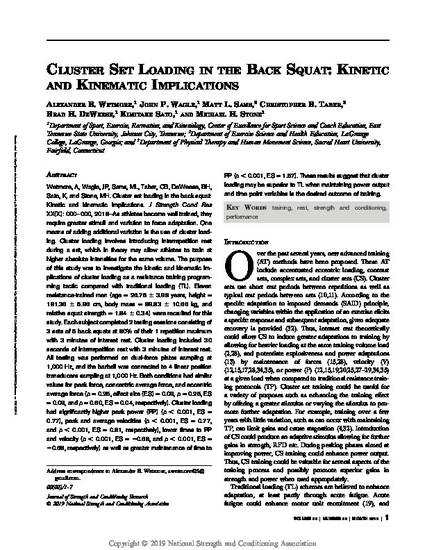
Article
Cluster Set Loading in the Back Squat: Kinetic and Kinematic Implications
The Journal of Strength and Conditioning Research
Document Type
Peer-Reviewed Article
Publication Date
7-1-2019
Disciplines
Abstract
Cluster set loading in the back squat: Kinetic and kinematic implications. J Strength Cond Res XX(X): 000–000, 2018—As athletes become well trained, they require greater stimuli and variation to force adaptation. One means of adding additional variation is the use of cluster loading. Cluster loading involves introducing interrepetition rest during a set, which in theory may allow athletes to train at higher absolute intensities for the same volume. The purpose of this study was to investigate the kinetic and kinematic implications of cluster loading as a resistance training programming tactic compared with traditional loading (TL). Eleven resistance-trained men (age = 26.75 ± 3.98 years, height = 181.36 ± 5.96 cm, body mass = 89.83 ± 10.66 kg, and relative squat strength = 1.84 ± 0.34) were recruited for this study. Each subject completed 2 testing sessions consisting of 3 sets of 5 back squats at 80% of their 1 repetition maximum with 3 minutes of interset rest. Cluster loading included 30 seconds of interrepetition rest with 3 minutes of interset rest. All testing was performed on dual-force plates sampling at 1,000 Hz, and the barbell was connected to 4 linear position transducers sampling at 1,000 Hz. Both conditions had similar values for peak force, concentric average force, and eccentric average force (p = 0.25, effect size (ES) = 0.09, p = 0.25, ES = 0.09, and p = 0.60, ES = 0.04, respectively). Cluster loading had significantly higher peak power (PP) (p < 0.001, ES = 0.77), peak and average velocities (p < 0.001, ES = 0.77, and p < 0.001, ES = 0.81, respectively), lower times to PP and velocity (p < 0.001, ES = −0.68, and p < 0.001, ES = −0.68, respectively) as well as greater maintenance of time to PP (p < 0.001, ES = 1.57). These results suggest that cluster loading may be superior to TL when maintaining power output and time point variables is the desired outcome of training.
DOI
10.1519/JSC.0000000000002972
PMID
30694961
Publisher
Wolters Kluwer
Pages
S19-S25
Creative Commons License
Creative Commons Attribution-NonCommercial 4.0 International
Citation Information
Wetmore, A., Wagle, J., Sams, M., Taber, C., Deweese, B., Sato, K. & Stone, M.(2019). Cluster set loading in the back squat: Kinetic and kinematic implications. Journal of Strength and Conditioning Research, 33(7), S19–S25. Doi: 10.1519/JSC.0000000000002972

Epublication, ahead of print. Open access journal.